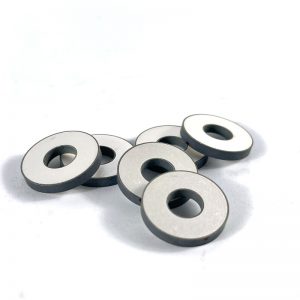 When voltage acts on piezoelectric ceramics, mechanical deformation occurs with changes in voltage and frequency. On the other hand, when piezoelectric ceramics are vibrated, an electric charge is generated. Using this principle, when an electrical signal is applied to a vibrator composed of two piezoelectric ceramics or one piezoelectric ceramic and a metal sheet, called a dual piezoelectric chip element, ultrasonic waves are emitted due to bending vibration. On the contrary, when ultrasonic vibration is applied to a dual piezoelectric chip component, an electrical signal is generated. Based on the above effects, piezoelectric ceramics can be used as ultrasonic sensors.
When voltage acts on piezoelectric ceramics, mechanical deformation occurs with changes in voltage and frequency. On the other hand, when piezoelectric ceramics are vibrated, an electric charge is generated. Using this principle, when an electrical signal is applied to a vibrator composed of two piezoelectric ceramics or one piezoelectric ceramic and a metal sheet, called a dual piezoelectric chip element, ultrasonic waves are emitted due to bending vibration. On the contrary, when ultrasonic vibration is applied to a dual piezoelectric chip component, an electrical signal is generated. Based on the above effects, piezoelectric ceramics can be used as ultrasonic sensors.
| spec | Dimension (毫米) |
Radial frequency (千赫) |
Capacitance (pf) |
Dielectric dissipation factor tanδ(%) |
Electromechanical coupling coefficient (Kr) |
Impedance Zr(Ω) |
Thickness frequency (千赫) |
| PU-PC25103 | Φ25×Φ10×3 | 66.4 | 1240±12.5% | ≤0.3 | ≥0.46 | ≤15 | 683±5% |
| PU-PC225104 | Φ25×Φ10×4 | 66.4 | 930±12.5% | ≤0.3 | ≥0.46 | ≤15 | 512±5% |
| PU-PC40155 | Φ40×Φ12×5 | 45.9 | 2070±12.5% | ≤0.3 | ≥0.46 | ≤15 | 410±5% |
| PU-PC40155 | Φ40×Φ15×5 | 42.2 | 1960±12.5% | ≤0.3 | ≥0.46 | ≤15 | 323±5% |
| PU-PC40176 | Φ40×Φ17×6 | 40.5 | 1555±12.5% | ≤0.3 | ≥0.46 | ≤15 | 341±5% |
| PU-PC40205 | Φ40×Φ20×5 | 37.9 | 1700±12.5% | ≤0.3 | ≥0.47 | ≤15 | 410±5% |
| PU-PC50206 | Φ50×Φ20×6 | 33.2 | 2490±12.5% | ≤0.3 | ≥0.46 | ≤15 | 341±5% |
| PU-PC501765 | Φ50×Φ17×6.5 | 34.8 | 2430±12.5% | ≤0.3 | ≥0.46 | ≤15 | 315±5% |
| PU-PC50236 | Φ50×Φ23×6 | 31.2 | 2340±12.5% | ≤0.3 | ≥0.47 | ≤15 | 341±5% |
| PU-PC50276 | Φ50×Φ27×6 | 29.3 | 2100±12.5% | ≤0.3 | ≥0.47 | ≤15 | 341±5% |
| PU-PC603010 | Φ60×Φ30×10 | 25.3 | 1922±12.5% | ≤0.3 | ≥0.47 | ≤18 | 205±5% |
 超聲波換能器,超聲波發生器,超聲波清洗機-SKSONIC
超聲波換能器,超聲波發生器,超聲波清洗機-SKSONIC







